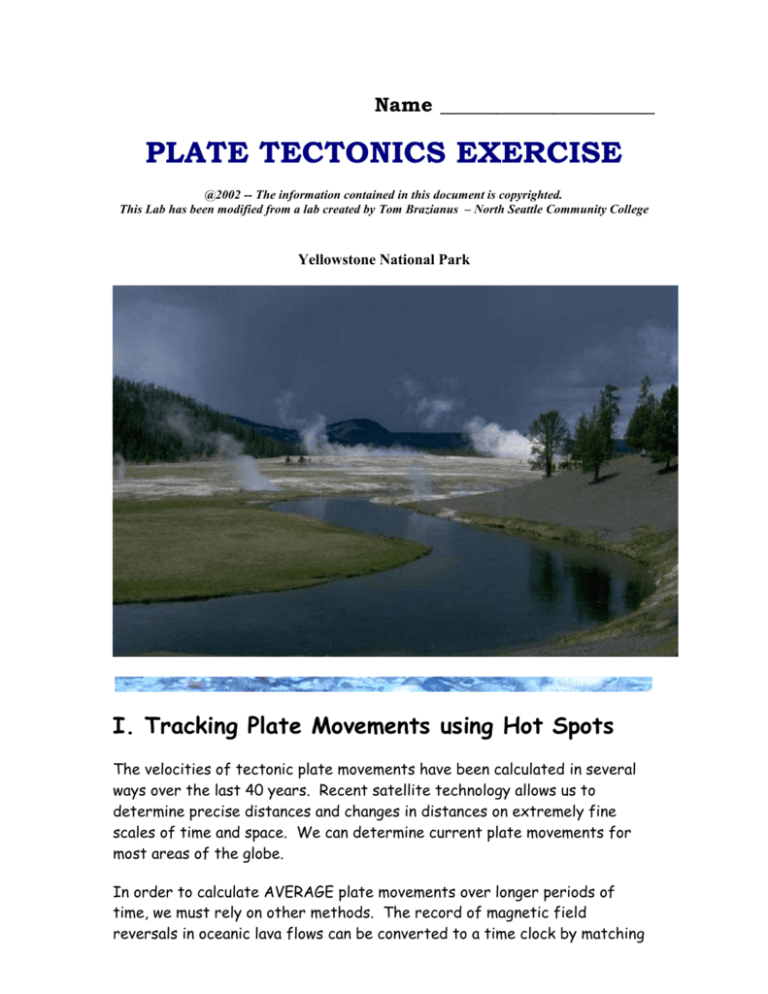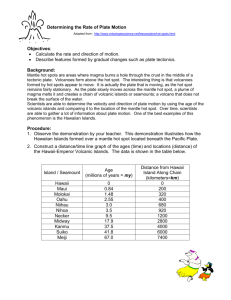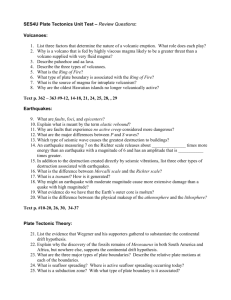Plate Tectonics
advertisement

Name ___________________ PLATE TECTONICS EXERCISE @2002 -- The information contained in this document is copyrighted. This Lab has been modified from a lab created by Tom Brazianus – North Seattle Community College Yellowstone National Park I. Tracking Plate Movements using Hot Spots The velocities of tectonic plate movements have been calculated in several ways over the last 40 years. Recent satellite technology allows us to determine precise distances and changes in distances on extremely fine scales of time and space. We can determine current plate movements for most areas of the globe. In order to calculate AVERAGE plate movements over longer periods of time, we must rely on other methods. The record of magnetic field reversals in oceanic lava flows can be converted to a time clock by matching the pattern of magnetic changes in these rocks with the same pattern (radiometrically dated) in basalts erupted on land. By using magnetometers on ships, scientists do not need to dive down and collect seafloor specimens to test and to date; instead the magnetic record on the seafloor can be determined from simple ship-board measurements. By knowing times and distances, we can then calculate how fast the seafloor has spread away from divergent plate boundaries. Another major means of calculating plate velocities is tracking the volcanic "footprints" of hot spots as tectonic plates move across them. We assume that a "hot spot" originates from a relatively stationary source deep within the Earth's mantle. As plates move, these deep-seated plumes "burn" new spots on the plates. These spots might be volcanic islands in the ocean or volcanic landforms on continents. The hot mantle plume is like a lit match. Hold a piece of paper over it and it will begin to burn a hole in that paper. Move the paper slowly and the match will burn a series of holes in the paper, the oldest "burn" being the one farthest away from the match. The "age" of the burns and their distance from the match can tell us how fast the paper has moved over it. P.S. DON'T TRY THIS AT HOME. The Hawaiian Islands, and Yellowstone National Park are examples of "hot spots." In this activity we will use readily available information for each of these geologic paradises in order to estimate how fast three specific tectonic plates have moved over the time of the last millions of years. II. Hawaiian Islands Hot Spot: The following geology lesson, images and activities are being used (with permission) from "A Teacher's Guide to the Geology of Hawaii Volcanoes National Park" (copyrighted by the Hawaii Natural History Association). It has been modified extensively for use in this lab. While visiting Hawaii in the 1960's, Tuzo Wilson, one of the founders of the theory of plate tectonics, noticed some interesting features about ocean islands. On a map of the Pacific basin, he found three linear chains of volcanoes and submarine volcanoes (seamounts). As shown below, these are the (1) Hawaii Islands -Emperor Seamounts; (2) The Pitcairn Island - Tuamotu Group; and (3) the Macdonald Seamount - Austral Group. Notice that the eastern most island or seamount of each chain is volcanically active. As we can see, although separated by thousands of miles, the three linear chains are parallel to each other. Of the three, the Hawaii-Emperor seamount chain was the most well known. Wilson reviewed the reports that had been published on these island chains and recorded the age of each island in the Hawaiian chain. An interesting pattern emerged. For each chain, the islands become progressively younger to the southeast. The extreme southeast end of each chain is marked by active volcanoes. Wilson proposed that the Hawaiian islands formed successively over a common source of magma called a hot spot. The Island of Hawaii is currently located above the hot spot. Hot, solid rock rises to the hot spot from greater depths (see the sketch below). Due to the lower pressure at the shallower depth, the rock begins to melt, forming magma. The magma rises through the Pacific Plate to supply the active volcanoes. The older islands were once located above the stationary hot spot but were carried away as the Pacific Plate drifted to the northwest Image Source: Eruptions of Hawaiian Volcanoes: Past, Present, and Future: U.S. Geological Survey General Interest Publication. . HOT SPOTS AND MANTLE PLUMES An Activity by Steve Mattox Directions: Use the map and the following information to determine the rate of motion of the Pacific Plate over the Hawaiian hot spot. The volcano that formed the Island of Niihau is 4.89 million years old. Rate is the distance traveled over a period of time. The distance traveled is equal to the distance from the present location of the hotspot (southeast Hawaii) to Niihau. Time is the age of the island. Question #1 Start by measuring the distance from southeast Hawaii to Niihau. Use the scale on the map. The distance is ________________ km. Question #2 To determine the average rate of motion for the Pacific Plate, divide the distance to Niihau by the age of the island. The rate of plate movement is _____________________ km/Ma (kilometers per millions of years). Question #3 Convert your answer to cm/yr (move the decimal to the left 1 place). The rate of Pacific Plate movement is _____________ centimeters per year. Question #4 Using this rate, how far will the Pacific Plate move in 50 years? ____________cm Question #5 Repeat the exercise above using the island of Molokai instead. From the distance and age of this island, the rate of Pacific Plate movement is ___________ centimeters per year. Question #6 Is this rate different than the rate calculated using Niihau? What might be one good reason why the rate would be different? __________________________________________________ Question #7 What direction is the Pacific Plate traveling? _________________ This next activity determines the average rate that the Pacific Plate has moved over the last 65 million years. The ages of the islands and seamounts increase with distance away from the Hawaiian hot spot. This table shows these ages and distances for islands and seamounts in the Hawaiian - Emperor chain. Seamount or Island -----Suiko Koko Midway Necker Kauai Distance (km) ------------4,860 3,758 2,432 1,058 519 Age (Million Yrs) --65 48 28 10 5 Question #8 Plot this data on the graph below. Once the points are plotted on the graph, use a ruler to draw a straight line that starts at the origin and most closely goes near all the data points (this is called a "best-fit" line). Determine the slope of the line (pick any point on the line and divide the distance value by the time value). This slope is equal to the average rate of plate motion. As determined from your work, this rate is __________________ kilometers / million years. Question #9 Convert your answer to cm/yr (centimeters / year): __________________ Question #10 Has the Pacific Plate been moving slower or faster over the last 5 million years than it has in the past? Explain. ____________________________ Question #11 The trajectory of plate motion points toward Hokkaido on the northern part of the Japanese Island chain, 6,300 km (3,900 mi) away. A subduction zone offshore of Japan consumes the Pacific plate, which is partly melted to create the volcanoes of Japan. If the "Plate Tectonic Express" operates without change, the Big Island of Hawaii will be headed down the Japanese trench. How long will it take Hawaii to reach Japan? Show your work. 6300km ÷ (Answer to Question #9 km/yr) = ? yrs _______________________________yrs III. Yellowstone National Park: Hot spots may occur on continental lithosphere as well as oceanic lithosphere. For example, Yellowstone National Park is a huge volcanic caldera (collapsed summit of a volcanic cone) which we believe had a culminating eruption some 600,000 years ago. This is only the latest in a series of major caldera-forming eruptions that have traveled across the pacific northwest during the last 16 million years. In fact, we can track the movement of this still-active volcanic hot spot as it has shifted from Oregon through Idaho (creating its Snake River Plain Volcanic Province) into Wyoming. In actuality, the hot spot is stationary. It is the North American plate which is moving across it. How fast is the plate moving? We can apply the same method as before in order to calculate this rate. Study the map below to determine the distance from the current hot spot to the 12.5 million year old Bruneau-Jarbridge Caldera in southern Idaho. Old Faithful Yellowstone National Park Snake River Plain - Yellowstone Eruptive Centers LC = 0.60 Ma Lava Creek Tuff AF = 7.48 Ma tuff of America Falls MF = 1.29 Ma Mesa Falls Tuff KC = 9.17 Ma tuff of Kyle Canyon HR = 2.00 Ma Huckleberry Ridge Tuff LR = 8.75 Ma tuff of Lost River Sinks H = 4.49 Ma tuff of Heise Ch = 9.34 Ma tuff of Little Chokecherry Canyon Ek = 5.37 Ma tuff of Elkhorn Springs AV = 10.09 Ma and 10.27 Ma tuff of Arbon Valley A & B WC = 5.81 Ma tuff of Wolverine Creek Tw = 8.6 to10 Ma Twin Fall Caldera CC = 5.94 Conant Creek Tuff Br-Ja = 10.0 to 12.5 Ma Bruneau-Jarbridge Caldera BC = 6.19 Ma tuff of Blue Creek Ow-Hu = ~13.9 to 12.8 Ma Owyhee-Humbolt Caldera W = 6.19 Ma Walcott Tuff M = 16.1 Ma McDermitt Caldera ES = 6.57 Ma tuff of Edie School Question #12 Using the Yellowstone Hot Spot calculate how fast is the North American plate moving? Show your work. Give your answer in centimeters per year. Rate = (distance mi) x (1.61 km/mi) x (100,000 cm/km) ÷ (time my) ÷ (1,000,000 yr/my) = ______ cm/yr _____________cm/yr Question #13 In what direction is the North American plate moving? ____________________ Question #14 Where do we expect the hot spot to be in another 12.5 million years? ___________________________________________________ Conclusion What are two things that you can figure out about tectonic plates from the observations of HotSpots? ___________________________________ _________________________________________________________________________________________________________________ The End






